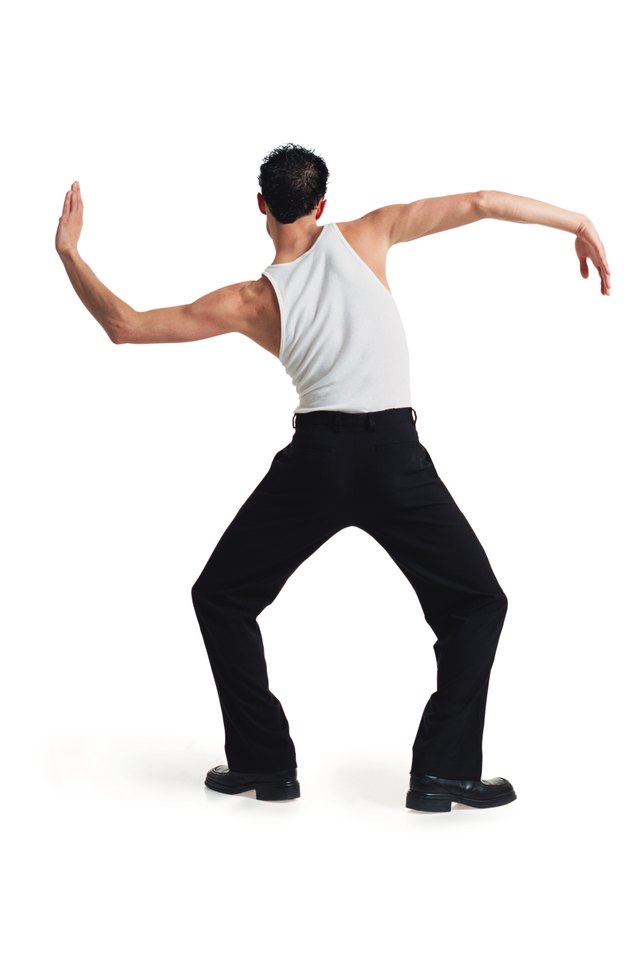Dance Isolation Exercises

Classical jazz choreography emphasizes rhythm, attitude and flair. To develop these qualities, jazz dance students typically begin every dance class with a structured warm-up that includes isolation exercises -- exercises that, as the name indicates, isolate specific body parts. Jazz teacher and choreographer Frank Hatchett considers body part isolations essential preparation for everything that follows in a dance class. Isolations are key to helping dancers develop a sharper, funkier style. As a dancer of any style – including ballet, modern, hip-hop, salsa and belly dancing – you can tap into the many benefits of jazz isolations and use this technique as a means to enhance your dance training.
Purpose
At the beginning of class, dancers use isolations to warm up specific body parts, including the neck, shoulders, rib cage and hips. When individual body parts are warm and supple, dancers can achieve greater fluidity as they progress to more complex movement combinations. Isolations also help a dancer tune into how every body part moves, which ultimately leads to greater coordination and versatility. Once a dancer can successfully isolate one body part, such as a shoulder or hip, she can combine movement of that body part with a traveling step, such as a grapevine or forward walk. If you're a beginning dancer who struggles with rhythm, isolations can help you “feel” the music, which improves movement quality and musicality. Hatchett also claims isolations can help a dancer develop greater precision and master challenging rhythms without losing control.
Technique
When you perform isolations, maintaining a wide stance with your knees slightly bent helps you feel grounded and relaxed and allows for greater joint range of motion. Position your shoulders square to the front of the room with your head aligned over your spine. From this position, you can rotate your head from side to side, drop it forward and back, and then circle it slowly around. For shoulder isolations, you can lift and lower each shoulder, lift and lower both shoulders simultaneously, and then complete slow shoulder circles forward and backward. Perform similar isolation sets with your rib cage and hips. The number of repetitions can vary with every isolation, but aim to move with the music and to transition smoothly from one isolation to the next. Some dance instructors have a fixed routine, while others vary isolation exercises every class. Your primary goal is to avoid moving the rest of your body when you isolate a given body part.
Form
Like everything else in dance, isolations improve with training and awareness of proper form. To avoid developing bad habits or straining certain muscles, you need to be conscious of your alignment. For example, jazz instructor Patti Wilcox warns that poorly executed shoulder isolations can result in hyperextending the rib cage or overworking the back muscles. Jazz teacher and choreographer Bob Rizzo points out that bending the head too far backward can result in neck strain. You need to focus on which muscles you’re working and control the range of movement at all times. Hatchett notes that you can challenge yourself with more difficult rhythms and movement combinations, but you should never do so at the expense of proper form.
Considerations
As Hatchett suggests, you should precede your isolation work with a more general warm-up and light stretching to raise your core body temperature, increase flexibility and reduce your risk of injury. Line dancer and author Christy Lane points out that it is not unusual for beginners to feel sore from isolations. If you are new to dance or have never worked with isolations before, mild discomfort is normal, but you should not experience pain. If isolation exercises result in serious discomfort, refrain from performing them until you consult with a professional dance instructor or your doctor. Learning proper technique from a professionally trained dancer will help ensure that you work safely and minimize the risk of injury. Once you are familiar with proper technique, using a mirror will enable you to self-correct when you're training alone.
References
- Frank Hatchett's Jazz Dance; Frank Hatchett and Nancy Myers Gitlin
- Christy Lane's Complete Book of Line Dancing; Christy Lane
- Dance Magazine: Break Your Bad Habits -- The Shoulders
- Dance Spirit: Isolation Inspiration
Writer Bio
Judy Fisk has been writing professionally since 2011, specializing in fitness, recreation, culture and the arts. A certified fitness instructor with decades of dance training, she has taught older adults, teens and kids. She has written educational and fundraising material for several non-profit organizations and her work has appeared in numerous major online publications. Fisk holds a Bachelor of Arts in public and international affairs from Princeton University.
